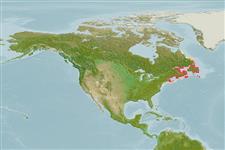Classification / Names
Common names from other countries
Main reference
Size / Weight / Age
Max length : 86.0 cm SL male/unsexed; (Ref. 7248); common length : 26.4 cm TL male/unsexed; (Ref. 12193); max. published weight: 8.0 kg (Ref. 100229); max. reported age: 24 years (Ref. 72501)
Environment
Marine; freshwater; brackish; benthopelagic; anadromous (Ref. 51243); depth range 15 - 27 m (Ref. 3899)
Climate / Range
Temperate; ? - 25°C (Ref. 35682), preferred ?; 65°N - 30°N, 95°W - 52°W
Distribution
North America: native to most of eastern Canada from Newfoundland and Labrador to western side of Hudson Bay; south in Atlantic, Great Lakes, and Mississippi River basins to Minnesota and northern Georgia (Applachian Mountains), USA; headwaters of Chattahoochee River (Gulf basin). Introduced widely in North America and temperate regions of other continents. Several countries report adverse ecological impact after introduction.
Countries | FAO areas | Ecosystems | Occurrences | Introductions
Short description
Dorsal
spines
(total): 3 - 4;
Dorsal
soft rays
(total): 8-14;
Anal
spines: 3-4;
Anal
soft rays: 8 - 14;
Vertebrae: 58 - 62. Distinguished by the combination of dark green marbling on its back and dorsal fin and by the red spots with blue halos on its sides (Ref. 27547). Pelvic fins with axillary process; caudal nearly straight or with a shallow indentation (Ref. 27547). Color varies, but generally rather green to brownish on back, marked with paler vermiculations or marbling that extend onto the dorsal fin and sometimes the caudal; sides lighter than back, marked with numerous pale spots and some red spots, each of the latter surrounded by a blue halo; anal, pelvic and pectoral fins with a white leading edge followed by a dark stripe, the rest of the fins reddish (Ref. 27547). In spawning fish the lower sides and fins become red (Ref. 27547). Sea-run fish are dark green above with silvery sides, white bellies and very pale pink spots (Ref. 27547). Caudal fin with 19 rays (Ref. 2196).
IUCN Red List Status (Ref. 115185)
Threat to humans
Potential pest
Human uses
Fisheries: minor commercial; aquaculture: commercial; gamefish: yes; aquarium: public aquariums
Tools
Special reports
Download XML
Internet sources
Estimates of some properties based on models
Phylogenetic diversity index
PD50 = 0.5000 many relatives (e.g. carps) 0.5 - 2.0 few relatives (e.g. lungfishes)
Trophic Level
3.3 ±0.0 se; Based on diet studies.
Resilience
Medium, minimum population doubling time 1.4 - 4.4 years (tm=1-3; tmax=7)
Vulnerability
Moderate vulnerability (43 of 100)
Price category
